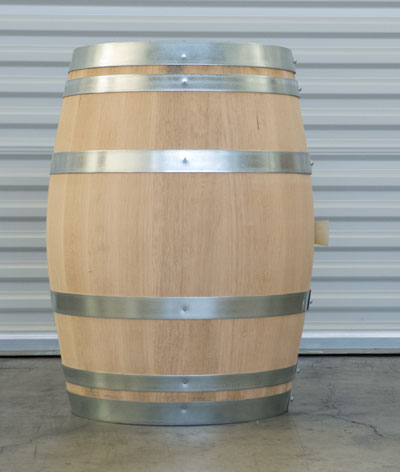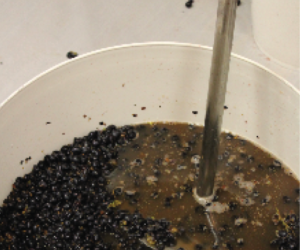
Q
I am considering making a five-to-six gallon batch of peach or apricot wine. A friend said I can add a can of white grape-juice concentrate (100% fruit) in place of an acid blend. Does this work?
Chuck Polage
via email
A
If you’re looking for a way to boost acid without adding extra sugar, stick to acid blend. Using grape-juice concentrate as an additional fermenting agent in fruit wines, on the other hand, is a good way to add extra acid, sugar, flavor and yeast nutrients.
Acid blends are often comprised of citric, tartaric and malic acids. They add tartness to your wine. Acid blends come in white powder form, which you dissolve in a little water or juice and then add to your fermentation.
Grape-juice concentrates are just that — juice concentrates. They pack a heck of a lot more than tartness and include water, carbohydrates of various stripes, amino acids, nitrogen, tartaric acid, citric acid, malic acid … lots of stuff that grapes naturally possess. If you want to add sugar and grapey flavors to your wine, use the juice concentrate. To boost tartness without adding anything else, go with the acid blend.
Q
I have read several sources that discourage the filtering (at 0.45 microns or less) of wine prior to bottling. They argue that flavors are stripped away by the filter. Other sources, not so numerous, hail filtering, saying that the process makes a wine drinkable at a much younger age. What is your opinion, as the oracle of the home winemaker?
Dr. Boyce Clark
Baton Rouge, Louisiana
A
To filter or not to filter, that is the question. For the home winemaker it often is less a question of quality than a question of cash flow or wanting to be bothered with it.
The reality is that filtering can be a fiddly bit of cellarwork that may involve a lot of new equipment, quite a bit of self-education and considerable trial and error. Some winemakers, even professional ones, just say “heck with it” and skip filtration.
If you’re considering filtering, you first must ask yourself what you’re trying to achieve. A common reason to filter, especially for whites, is to achieve a sterile environment in the bottle. You may not want your wine to go through malolactic fermentation, or maybe it’s sweet and you don’t want any ambient yeast cells conducting an illicit post-bottling fermentation.
The 0.45-micron filter will not let any microbes, even those as small as bacteria, pass through. This is considered a “sterile” filtration in the industry. It will ensure that your bottled wine will be as stable as possible — assuming everything else is sterile as well, including the bottle. Sterile filtration can be useful for commercial winemakers, but it isn’t practical, or even possible, with most standard home-winemaking equipment.
Another reason to filter is clarity. I can’t tell you how much it spoils my experience when I’m judging a home winemaking competition and someone presents me with a cloudy Chardonnay. Not all commercial white wines are filtered either, but it’s certainly considered poor form to sell a hazy bottle. To achieve clarity it’s not necessary to use a 0.45 micron filter — sometimes using pad filters (cellulose “paper” pads of varying degrees of “tightness”) is enough to achieve visual clarity.
Stability and clarity are good, right? Right, but not if you have to sacrifice quality. If you’re forcing your wines though a small pore size or nasty paper-flavored pads that didn’t pass the supplier’s quality-control specs, you might suffer setbacks.
Some winemakers believe that you’re “stripping” your wine of flavor, color or aromatic compounds when you filter, no matter how you do it or what you use. There have been many studies on this point over the years. The only consensus seems to be that filtering can certainly change a wine’s character … though I haven’t found evidence to prove that over time it’ll have any noticeable effect.
Red wines seem to change the most when filtered. Since they are dry, red wines are more stable than whites (most reds go through malolactic fermentation and are usually fermented dry). So it makes sense to filter reds only when necessary. Commercial red table wines are hardly ever brilliantly clear. If you shine a beam of light through them you’ll see a tiny bit of haziness. This is entirely normal.
Homemade white wines should at least look clear — and you don’t have to go through a “sterile” filtration to achieve that brilliant look. If you rack cleanly and carefully, if your wine has gone through malolactic and you’re not worried about secondary fermentation in the bottle, you may not have to filter your white wines at all. Some of the most famous Chardonnay producers in the world don’t filter their white wines.
Filtering never hastens the aging process (in fact, some might argue that it hinders a wine’s development). Whatever your aim, the rule is to filter only if you have to or really want to. (For a complete rundown on filtering, see “Clear it Up” in the October-November 2002 issue of WineMaker.)
For more of the Wine Wizard’s wisdom, pick up the latest issue of WineMaker magazine, now available at better home winemaking shops and newsstand locations.







